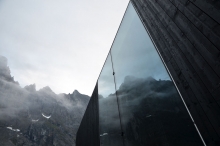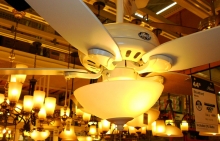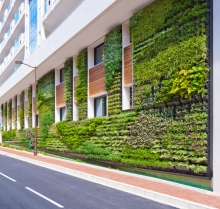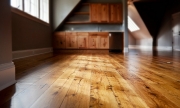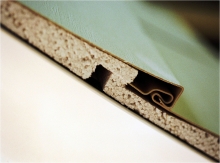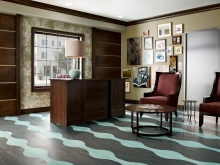- Error
{Re}habitat
Learn how adaptive reuse and upcycling can add hip design to your home, apartment, or yard with the Go Green channel's {Re}habitat series. Follow host Rachael Ranney as she shows you how to repurpose salvaged and found materials, adding fun and function to your space without breaking your budget.

The Trollveggen made Architectural Digest's list of 10 most beautifully designed restaurants – read more about the visitor center and cafeteria elevated by its modernist architechture.
Reiulf Ramstad Architects designed a new tourist center and restaurant at the base of the Troll Wall, Europe’s tallest rock face. The form and material palette of the center mimics its stark landscape, and the resulting design is so dynamic it just might steal the show.
Tourist centers with restaurants are necessary and inevitable fixtures along scenic roadways. Usually they are utilitarian structures that peddle gaudy souvenirs and greasy food. However, in Norway, road-trippers have a more modern and elegant option when it comes time to make a pit-stop. The new tourist center situated at the base of Norway’s Troll Wall, or Trollveggen—Europe’s tallest vertical rock face, located in the Romsdal Valley along the western side of the country—is a welcome exception to this tired typology.
Ceiling fans are an old-fashioned but effective and efficient approach to comfort.
Ever since one of our ancient ancestors picked up a palm leaf and used it to stir a cooling breeze, fans have played an important role in keeping us comfortable. From simple, hand-powered devices used to content Egyptian pharaohs, fans have evolved into automatic, efficient, climate-control appliances. Developed by father John and son James C. Hunter in 1886, the mechanical ceiling fan remains the most successful improvement. Even with the advanced climate control systems available today, ceiling fans provide an economical means of providing indoor comfort. As a supplement to central air conditioning, a ceiling fan can save 10% to 15% on summer cooling costs. In certain circumstances, a ceiling fan can help to balance home air temperatures for more efficient heating.
Many buildings are literally going green. The addition of a vertical garden, whether interior or exterior, has many benefits.
The benefits of gardening are numerous, but gardening also requires land – something that many commercial and urban settings lack. However, vertical gardening is a fairly simple way to enjoy the aesthetics of plants within a limited space. Vertical gardens grow upward alongside building exteriors and interior walls, creating captivating scenery where it would otherwise be impossible.
How to Determine a Construction Contract Start Date After Initiation
Written by David A. Todd Fri Jun 08 2012Welcome to the On Site channel’s Construction Administration Column. If you are midway through a project, how do you determine the official start date?
Columnist David A. Todd, P.E., CPESC, has 37 years of experience in the architecture, engineering, and construction (AEC) industry and has performed much construction administration during that time. He will answer questions from our readers or from his own practice and will provide answers based on his understanding of the construction process and administration of the construction contract. The focus will be on the customary duties of the owner, contractor, and design professional as typically described in the contract documents.
The Character and Durability of Reclaimed Wood Flooring
Written by Lisa Taylor Minor Wed Jun 06 2012What makes reclaimed wood so appealing? Its appeal is based on more than just the patina it has acquired during its years of use as a building material… the character associated with old wood started developing when it was still in the forest.
Wood utilized more than a century ago in the construction of old barns, factories, and warehouses throughout the United States is now one of the most highly desirable and sought-after raw materials in the flooring industry. Popular in both residential and commercial environments, vintage reclaimed wood flooring is appreciated by architects and designers for its history, quality, character, and environmental benefits.
This second of our insulated siding articles focuses on the technical aspects of using this exterior cladding as an insulation product. We will also touch on some relevant details regarding its installation.
The industry definition of insulated siding, or IS, is an exterior cladding product with a significant thickness of insulation permanently adhered, so that both cladding and insulation are installed in one step and as one product. This is currently limited to some aluminum and many vinyl siding products. (There also exists a line of contoured foam insulation manufactured as either a universal backing, or a product-specific backing for several types and brands of solid plank siding, including fiber cement. We will discuss this material separately.)
Innovations in Flooring: Carpet and Tile Made from BioBased Materials
Written by Lisa Taylor Minor Mon Jun 04 2012Manufacturers are updating their product lines with renewable, plant-based materials.
Throughout the last decade, flooring manufacturers have embraced sustainability as a catalyst for reducing waste; improving manufacturing processes; and developing innovative, more environmentally friendly flooring options. As a result of these efforts to minimize environmental impact, the standard synthetic raw materials utilized in the flooring of years past are now being replaced (or used in conjunction) with unconventional, biobased plant materials, such as corn starch, soybean oil, and castor bean oil.
How often do you need to clean your ductwork? Recommendations vary, so individual circumstances and preferences should dictate the timing of this task.
Every day we bring dirt and dust particles inside our homes from the great outdoors. We also generate dirt and dust indoors, depending on our daily activities. As the particles become airborne, they get drawn into our HVAC systems. (Our children may even drop toys, socks, or balls into them as well). As this continues over time, particles build up along the inner walls of the ductwork. Imagine what your furniture or floors would look like if you never dusted them. Cleaning up the accumulation of dirt, dust and debris inside your ductwork is common sense and part of good housekeeping.
